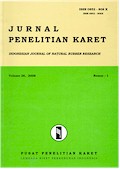| Journal Article |
 |
|
| Article Title | Pembangunan wanatani berbasis karet pada lahan terdegradasi alang-alang di Kalimantan Barat (Development of
Rubber Agroforests on Degraded Imperata Grassland in West Kalimantan) | | Author | Elok Mulyoutami, Laxman Joshi, Ilahang, Gede Wibawa and Eric Penot | | Year | 2008 | | Journal Title | Jurnal Penelitian Karet | | Institution | Balai Penelitian Sungei Putih, Pusat Penelitian Karet Indonesia | | Volume | 26 | | Issue | 1 | | Pages | 20-30 | | Call Number | JA0338-09 | | Keywords | Hevea brasiliensis, Imperata cylindrica, shading, cover crops, clones, weed competition, naungan, tanaman penutup, klon, kompetisi gulma | | Notes | ISSN 0852-808 X |
|
| Abstract: |
| Imperata grassland covers large areas of West Kalimantan. Trials of rehabilitation of Imperata land for planting rubber (Hevea brasiliensis) indicate that this is possible with limited resource (labour including) input. Rubber Agroforestry System 3 (RAS3) on-farm trial in West Kalimantan was a part of a large network of testing rubber agroforestry systems in Indonesia. Annual crops (rice, chilli, vegetables) were grown in the first year only. Either non-vine cover crops (Mucuna, Flemingia, Crotalaria, Setaria and Chromolaena) or multipurpose trees (such as Gliricidia) and fast growing trees (FGT) (such as Paraserianthes falcataria, Acacia mangium and Gmelina arborea) for pulpwood were planted immediately after rice harvest. Shading of these trees suppressed Imperata growth. Potential of cover crops to suppress Imperata growth varied between species. Pueraria and Mucuna was the most effective suppressor of Imperata whereas Crotalaria proved ineffective. Rubber trees in the control plots
(without cover crops) had the slowest growth. The FGT trials in Trimulya village showed that not all FGTs were successful in controlling Imperata regrowth. The time of rubber trees on FGTs plots to reach mature period (recommended tapping size) was prolonged by more than a year compared with those in legume cover crops or LCC (Pueraria and Mucuna) plots. The FGTs, particularly Acacia, grew rapidly and affected rubber trees in the first years; hence farmers cut down all remaining FGTs in the third year. These rubber agroforests not only increase farmer income, but also provide better environmental condition compared with Imperata covered land. |
|
|
Download file(s): Click icon to download/open file.
|
| |
File Size |
Description |

|
17 KB |
Abstract |

|
- |
URL |
|
|
GRP 2: Maximizing on-farm productivity of trees and agroforestry systems
|
| Viewed in 2280 times. Downloaded in 702 times. |